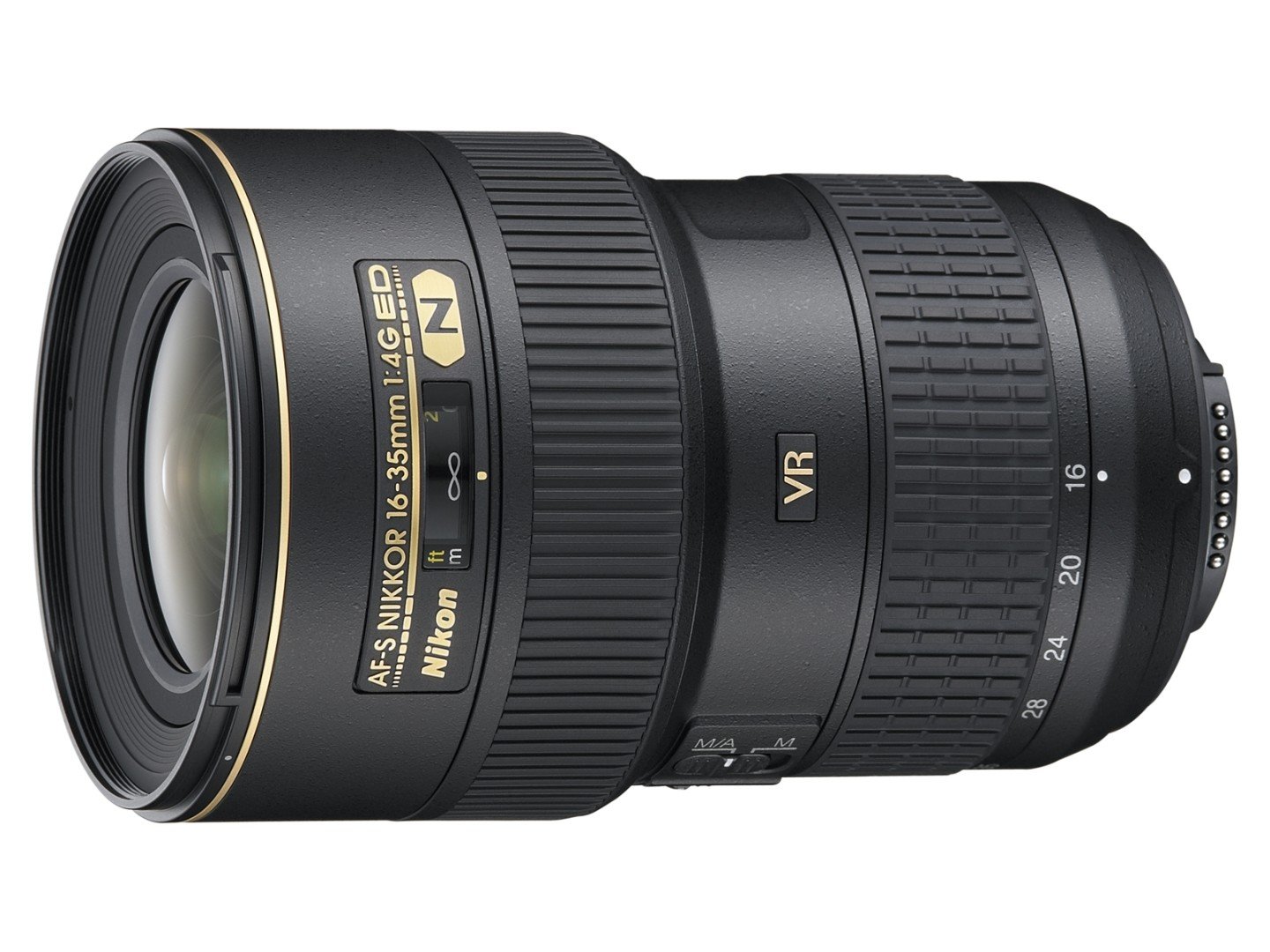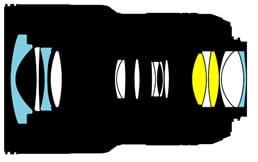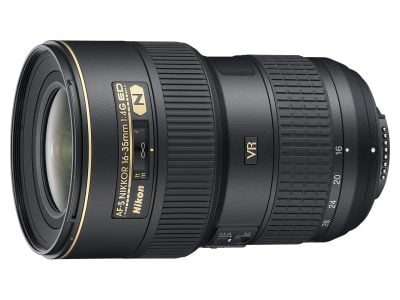Facts from the catalog
As usual I’ll have a look at the technical data first. I’ve rated the features with a [+] (or [++]), when it’s better than average or even state of the art, a [0] if it’s standard or just average, and [-] if there’s a disadvantage. I’ll compare it with Nikon’s AF-S 18-35mm f3.5-4.5G (“18-35” for short) which is a cheaper alternative if you need a full-frame wide-angle zoom.
Size (diam. x length): 83 x 125 mm (3.3 x 4.9 in.). 30mm longer than the 18-35. [0]
Weight: 680 g (24 oz.). The 18-35 comes in at only 385g. [-]
Optics: 17 elements in 12 groups vs. 12 elements in 8 groups for the 18-35. Pretty complex design with a lot of glass/air-surfaces. Features Nano-coating plus 2 extra dynamic glass and 3 aspherical lens elements. [0]
Closest focus distance/max. magnification: 0.28 m (0.9 ft.) / 1:4. The 18-35 offers slightly less magnification at 1:5. [0]
Filter-thread: 77mm = standard with most pro-lenses. Same with the 18-35. [+]
IS: Yes = it’s the only wide-angle zoom with stabilization for Nikon bodies. [+]
AF: AF-S with SWM (silent wave motor), so it does work on D60/3×00/5×00-bodies, manual-focus override is by turning the focus ring. Same with the 18-35. [+]
Covers full frame/FX or smaller = very good. Same with the 18-35. [+]
Price: around 950 EUR new (incl. 19% VAT) = not cheap. That is 50% more than the 18-35 (which does not feature image stabilization). See above for the latest pricing. [-]
Comes with a flexible lens pouch, the lens-shade is included, reversible for transport, and the lens-caps are standard Nikon’s. [0]
Distance information is relayed to the camera, so the Nikon body can do all the advanced exposure-related stuff with this lens. But this is true for all alternatives too. [+]
Aperture ring = no, just like all competitors. [0]
Sealing: a rubber grommet at the lens-mount. Same as the 18-35. [+]
The score in the “features-department” is 2[-]/5[0]/6[+]. This lens ticks many important boxes, like a constant f4.0 aperture and VR although an image stabilization at such short focal lengths may be of limited use: It enables you to use shutter speeds below 1/10 sec hand-held which is good for static subjects but increases the risk of motion blur from moving subjects. But the VR certainly comes in handy with architecture shots in low light and interiors. On the negative side is the pretty high price and the large size.
Alternatives
:
There are many alternatives in this category of wide-angle full-frame zoom:
– The closest competitor is the Tokina AT-X 17-35mm f4.0 FX. It only lacks 1mm focal length on the wide end and has no image stabilization but it is only two-thirds of Nikon’s price. Tokina also offers the AT-X Pro 16-28mm f2.8 FX which is a little more expensive but offers a constant f2.8 aperture. It starts at 16mm like the Nikon but only reaches 28mm on the long end which is 20% shorter than the Nikon. So you need to crop 20% to get the same framing as with the 35mm of the Nikon which in turn means giving up 36% of pixels from your sensor. So instead of working with the, say, 24MP of a D610 you’re left with 15.4MP.
– Sigma offers the 12-24mm F4,5-5,6 DG HSM II. It is 2/3 of a stop darker and covers a much shorter range of focal lengths. Indeed it is the shortest zoom covering a full-frame sensor starting at 12mm which is 25% shorter than the Nikon. It is in the same price range than the Tokinas so if you’re into extreme wide-angle photography you might have a look at this lens. Keep in mind though that 24mm is 33% shorter than 35mm and you would give up 56% of your sensor’s pixels to get to the same framing as with 35mm focal length.
– Nikon has three other lenses in this range if you discount the older AF 18-35mm f3.5-4.5D ED. There’s the AF-S 18-35mm f3.5-4.5G ED for around 600 EUR (see my Nikon 18-35mm review) plus two professional grade constant f2.8 aperture lenses: the AF-S 17-35mm f2.8D ED which is an older design from 1999 and the AF-S 14-24mm f2.8G ED from 2007 (see my Nikon 14-24mm review). The latter pair are naturally the most expensive of the alternatives costing around 1400 EUR and 1500 EUR respectively.
This makes a total of seven lenses in this range, so you have to decide carefully what you want or need and what your wallet is capable of. First I’d decide which focal range you need: 16-35mm does not sound interesting to someone with a DX-body who is used to shooting with a standard zoom starting at 16mm or 18mm and reaching 55mm or further. But remember: these lenses cover full-frame sensors and have a field of view that is equivalent to a focal length of around 11mm on a DX-body respectively. So if you own or are planning to buy a full-frame body then 16mm or even 18mm is already pretty wide. And 35mm on the long end would still be considered a mild wide-angle. Only if you’re really into extreme wide-angle would I suggest to look for zooms that start at 12mm or 14mm focal length.
Focus and build quality
Focus accuracy and repeatability is critical to consistently produce sharp shots. Repeatability (the accuracy of focus on the same subject after repeated focus-acquisition) of this lens is very good with no real outliers over a series of 40 shots. I only found 4 shots with very mild mis-focus visible only at 100% magnification. There is no performance variation whether the lens focuses coming from infinity or from minimum focus distance. Focus acts very fast at 0.5 seconds. The focus ring turns only 50 degrees, which is very short but is still enough to make accurate focus wide open at the long end easy. Unfortunately there was some play between the focus-ring and the internal gears on my copy of the lens. The focus-ring runs very smooth and AF-operation is very quiet from the outside but records audible clacks and some snaring sounds from the built-in microphone. VR-operation on the other hand is quiet even in recordings. At 35mm the lens exhibits almost no focus-breathing, but at shorter focal lengths the lens exhibits some shrinking (reduction of the image magnification) the closer you focus.
In general the impression of build quality is that of an upmarket albeit not pro lens: a solid plastic construction combined with a weather sealed metal lens-mount, and nine rounded aperture blades.
Now it’s time to check out the results in my Nikon 16-35mm quality and Nikon16-35mmsample images pages, or if you’d like to skip to chase, head straight for my verdict!

 "Stuck in the middle" comes to my mind: The Nikon 16-35/4.0G VR has a lot going for it: the zoom range is very practical for a wide-angle zoom, and starting at 16mm, not 18mm as other alternatives do, is also a slight plus. Plus a constant aperture and image stabilization make it a proposition that would be pretty attractive had it not been for the somewhat disappointing performance especially considering the price.
For a lens costing close to 1000 EUR I'd have expected a better image quality - simple as that. It's also not the lightest and smallest zoom in this range. Still, valued on its own it is a worthy compact wide-angle-zoom for those who start into FX-land or want to keep their options open for a future upgrade to an FX-body. It has a similar optical performance as the cheaper 18-35/3.5-4.5 plus offers image stabilization, a shorter 16mm plus constant f4 aperture for its higher price.
"Stuck in the middle" comes to my mind: The Nikon 16-35/4.0G VR has a lot going for it: the zoom range is very practical for a wide-angle zoom, and starting at 16mm, not 18mm as other alternatives do, is also a slight plus. Plus a constant aperture and image stabilization make it a proposition that would be pretty attractive had it not been for the somewhat disappointing performance especially considering the price.
For a lens costing close to 1000 EUR I'd have expected a better image quality - simple as that. It's also not the lightest and smallest zoom in this range. Still, valued on its own it is a worthy compact wide-angle-zoom for those who start into FX-land or want to keep their options open for a future upgrade to an FX-body. It has a similar optical performance as the cheaper 18-35/3.5-4.5 plus offers image stabilization, a shorter 16mm plus constant f4 aperture for its higher price.




